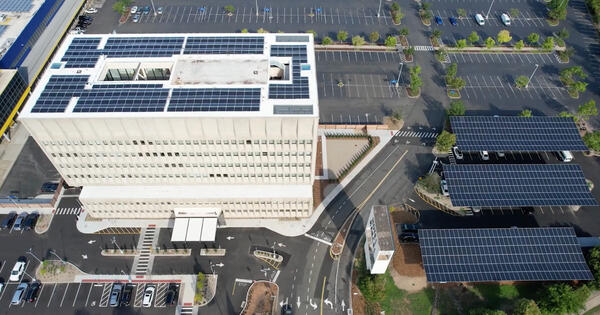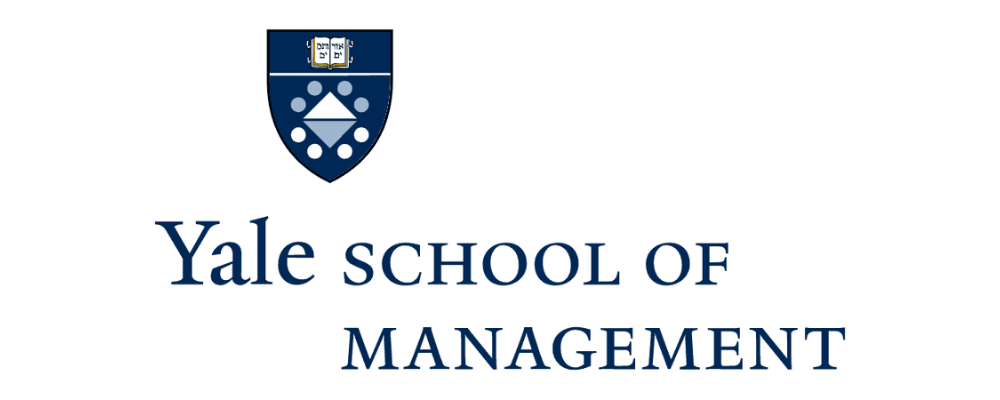
“If you care about climate change, you have to care about buildings,” said Jessica Bailey, CEO of Nuveen Green Capital. Her work scaling a financing mechanism called C-PACE (Commercial Property-Assessed Clean Energy) has helped building owners fund over $7 billion in clean energy and efficiency projects.
Yet, she added, “I think of what we do as stealth sustainability.” Since most developers are focused on the bottom line, “we had to figure out a way to help building owners solve not just their carbon problem but their economic problem,” explained Bailey, who received her master’s degree in international relations from Yale in 2004. “We created a good financial product. It enables those interested in implementing sustainable projects to make the case to their CFO.”
Whether by stealth or overt means, cutting the climate impacts of the sector is important. The International Energy Agency reported that building operations accounted for 26% of 2022 global energy system emissions. Yale SOM finance professor Cameron LaPoint said, “To reach 2030 net zero emissions targets, we would need to reduce the output of carbon emissions in the building sector by 10% year on-year. That’s a lofty goal.”
Bailey and LaPoint spoke at a Yale SOM real estate colloquium, “Opportunities for Green Property Retrofitting in a Post-COVID World.” They were joined by Brian Murray ’10, CEO of Shift Capital, and developer Bruce Becker ’85. Moderator Stuart DeCew, executive director of the Yale Center for Business and the Environment described the three visiting alumni as “people who think at the edges of things to figure out the toughest challenges in real estate.”
LaPoint offered a real-world case study to show that sharply reducing carbon emissions from buildings is possible: the Hotel Marcel in New Haven, developed by Becker. A deep retrofit turned the Brutalist landmark into an all-electric property that has the capacity to operate off grid thanks to battery storage for the power from its 1,000+ solar panels. Becker hopes to obtain certification for Hotel Marcel as the nation’s first Net Zero hotel.
As long as you’re looking at things as a zero sum you overlook opportunities. Sometimes, if you do more it costs less.
Becker predicted that 100 years from now people will be baffled by our high-carbon-intensity choice to build new buildings in lieu of retrofitting. “They will ask, ‘Why wasn’t everyone prioritizing retrofitting?’”
When federal, state, and other incentives for green retrofits are tallied, he said, “I actually believe that it’s more economical and less expensive to go this route. The problem is that a lot of people in the real estate industry are doing things the way they’ve always been done, so it’s taking a while to shift.”
The building industry is not just slow to change; it’s actually backsliding. Construction workers in 2020 were less productive than their peers in 1950. By comparison, worker productivity in manufacturing grew ninefold in the same period and overall worker productivity improved 290%.
There are further complications in the post-COVID economy, where office buildings struggle to find tenants, interest rates have shot up, inflation has pushed up the cost of materials, and lenders are risk averse after the collapse of Silicon Valley Bank. “The last two years have multiplied the challenges facing pretty much anyone in the real estate space,” said Murray. Paradoxically, with business as usual off the table, more developers may be forced to do things differently.
He added that experiments and unusual approaches are in Shift Capital’s DNA. “I’m of the mindset that the solution is, ‘Yes, and.’”
That expansive view was reflected in his take on his company’s approach to sustainability. “I’m usually not on an environmental panel,” Murray noted. “I’m not doing LEED-certified buildings, but I would argue investing in urban neighborhoods on public transportation is just as impactful environmentally.”
Examples of the company’s work include a project converting commercial space into residential in Newark and another that used the first C-PACE loan in Pennsylvania for a mixed-use textile mill retrofit in a Philadelphia neighborhood with a median income of $22,000. “We are pushing the envelope on retrofit strategies,” Murray said. “Our focus is creating equitable neighborhoods in underserved places.”
C-PACE loans, the financial tool Bailey help grow from a nascent idea, are now available in over 30 states. “At its core, C-PACE is public policy,” she explained. “The policy is super simple it says energy upgrades in our state are a public benefit.” Somewhere between a mortgage and a municipal bond, C-PACE loans are repaid through tax assessments. The implicit government backing allows lenders to offer better interest rates and longer terms than other forms of financing. That can mean that annual payments may be smaller than the annual savings that result from the project. When that’s the case, it’s hard to argue with doing what’s best for the climate.
Becker echoed the value of seeking better options. “As long as you’re looking at things as a zero sum you overlook opportunities,” he said. “Sometimes, if you do more it costs less.”
That doesn’t mean it’s easy. One of the sticking points in reducing the emissions of the Hotel Marcel, Becker noted, was laundry, which typically accounts for about 25% of a hotel’s energy use. Super-efficient commercial heat pump dryers aren’t for sale in the U.S., but he was eventually able to import them from Sweden. Despite the higher upfront costs, it was an obvious win. “The payoff time is something like six months—it’s crazy. This saves us a ton of money,” Becker said. “If the whole hotel industry would shift, within a couple years the industry could actually meet its emissions reduction targets.”
Becker warned that even with a commitment to reducing energy use, it’s easy for a company’s attention to wander. “It’s no one’s job to not use carbon,” he said. What’s needed, he said, is for the entire team to embrace a cross-disciplinary approach and proactively look for better, more-innovative green solutions.
Murray also pointed to Europe as a source of cutting-edge ideas around the built environment, green financing strategies, and new technologies. But, he noted, real hurdles remain the U.S. Recently, after his team put in two years of careful work to assemble project funding from a dozen different investors, one lender rescinded approval—effectively sending the project back to square one.
Bailey underscored the challenges. “It’s a grind trying to create something that doesn’t exist or change the way people do things,” she said. “It can be super frustrating. You can feel like you’re making such incremental progress that you’re not having an impact.” But, over time, an approach that started at the margins can be broadly accepted. Bailey has seen that happen with C-PACE. “We are transitioning the way we finance clean energy and the way we build buildings. And that’s cool.”
“The Yale School of Management is the graduate business school of Yale University, a private research university in New Haven, Connecticut.”
Please visit the firm link to site


